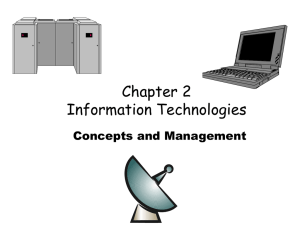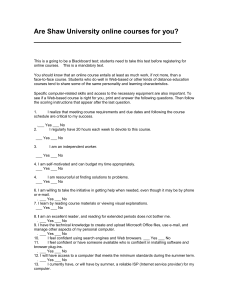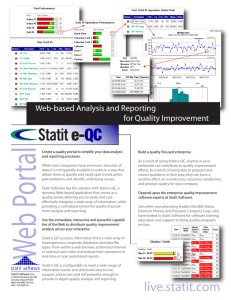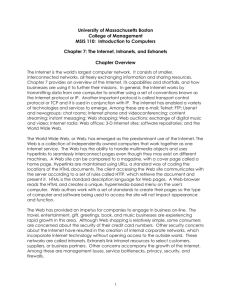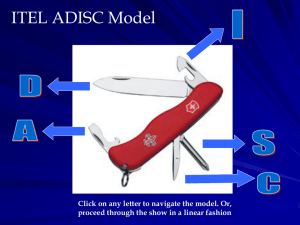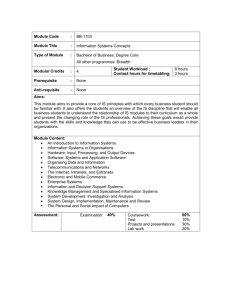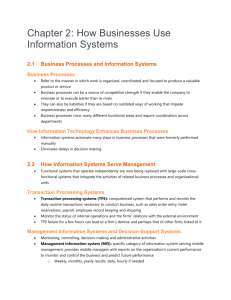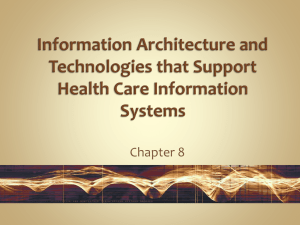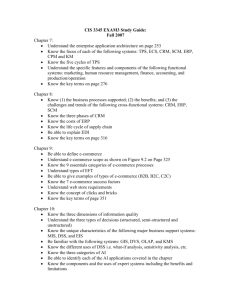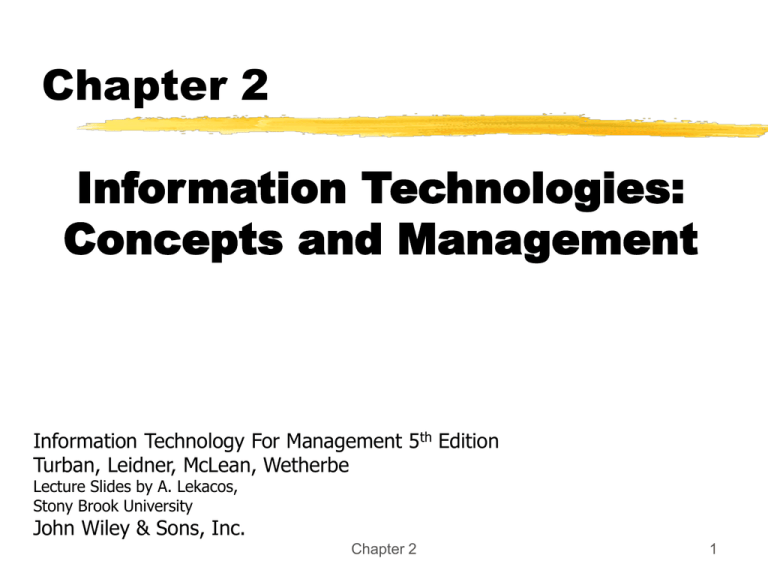
Chapter 2
Information Technologies:
Concepts and Management
Information Technology For Management 5th Edition
Turban, Leidner, McLean, Wetherbe
Lecture Slides by A. Lekacos,
Stony Brook University
John Wiley & Sons, Inc.
Chapter 2
1
Learning Objectives
• Describe various information systems and their evolution,
and categorize specific systems you observe.
• Describe and contrast transaction processing and functional
information systems
• Identify the major internal support systems and relate them
to managerial functions.
• Describe the support IT provides along the supply chain,
including CRM.
• Discuss information infrastructure and architecture.
• Compare client/server architecture, mainframe-based legacy
systems, and P2P archcitecture and comment on their
differences.
• Describe the major types of Web-based information systems
and understand their functionalities.
• Describe new computing environments.
• Describe how information resources are managed and what
are the roles of the ISD and end users
Chapter 2
2
Information System :
Concepts and Definitions
An information system (IS) collects, processes, stores,
analyzes, and disseminates information for a specific
purpose “Application”.
•
•
•
•
•
•
Hardware
Software
Data
Network
Procedures
People
Hardware
Software
Application
Data
People
Chapter 2
3
Information System – Primary Purpose
Collects data, processes it into information then converts
information into knowledge for a specific purpose.
• Data
• Elementary description of things, events, activities, and
transactions that are recorded, classified, and stored, but not
organized to convey any specific meeting
• Information
• Data that has been organized so that they have meaning
and value to the recipient
• Knowledge
• Information that has been organized and processed to
convey understanding, experience and expertise as they
apply to a current problem or activity
Chapter 2
4
Information System
– Classification By
Organizational Structure
An information system (IS) can span departments,
business units and corporations.
PC
PC
Unix
Enterprise
Server
PC
Hub
• Departmental IS
• Enterprise-Wide IS
• Inter-Organizational IS
Serial Terminals
In-house operations
Thin
Client
Mux
Thin
Client
DIALUP/T1/T3/ISDN/FRAME RELAY
DIALUP/T1/T3/ISDN/FRAME RELAY
Mux
Information systems are
usually connected by means
of electronic networks
Thin Client
PC
Appliance
Unix
Enterprise
Server
Appliance
Server
Store 3
On-line Multi-station Store
Store Location 1
Chapter 2
Mux
Thin Client
PC
Appliance
Appliance
Server
Store 3
On-line Multi-station Store
Store Location 2
Online Telenet System using the Internet
5
Information System - Classification
By Function (Department)
An information system (IS) support each department in
a corporation.
•
•
•
•
•
Operations
Accounting
Finance
Marketing
Human resources
Point-of-Sale (POS)
Transaction Processing Systems (TPS): Automates
routine and repetitive tasks that are critical to the
operation of the organization
Chapter 2
6
Information System
- Classification By
Function (Department)
An information system (IS) support each department in
a corporation.
Chapter 2
7
Information System
- Classification By
Support Function
Senior Mgr
Executive Support System
•5-year sales trend
•Profit Planning
•5-year budget forecasting
•Product development
Management Information System
Decision Support System
Middle Managers
Intelligent Support Systems
Knowledge Management System
Office Automation System
Transaction Processing System
Data Workers
Operational Managers
Chapter 2
•Sales Management
•Inventory Control
•Annual budget
•Production Scheduling
•Cost Analysis
•Pricing Analysis
•Simulation
•Pgm coding
•System support
•Word Processing
•Desktop Publishing
•Order Processing
•Fulfillment
•Material Movement
•A/R, A/P, GL
•Payroll
•POS
8
Information System
- Classification By
Support Function
Chapter 2
9
Transaction Processing System (TPS)
• TPS automates routine and repetitive tasks that are
critical to the operation of the organization, such as
preparing a payroll, billing customers, Point-of-Sale and
Warehouse operations.
• Data collected from this operation supports the MIS and
DSS systems employed by Middle Management
• Computerizes the primary and most of the secondary
activities on the Value Chain.
• Primary purpose to perform transactions and collect
data.
Chapter 2
10
Management Information Systems (MIS)
• These systems access, organize, summarize, and
displayed information for supporting routine
decision making in the functional areas. Geared
toward middle managers, MIS are characterized
mainly by their ability to produce periodic reports
such as a daily list of employees and the hours they
work, or a monthly report of expenses as compared
to a budget
• Typical uses would be in Replenishment, Pricing
Analysis (Markdowns) and Sales Management
• Decisions supported are more structured.
• Primary purpose to process data into information
Chapter 2
11
Decision Support Systems (DSS)
• These systems support complex non-routine
decisions.
• Primary purpose to process data into information
• DSS systems are typically employed by tactical
level management whose decisions and what-if
analysis are less structured.
• This information system not only presents the
results but also expands the information with
alternatives.
• Some DSS methodologies
•
•
•
•
•
Mathematical Modeling
Simulation
Queries
What-If (OLAP-Cubes)
Data mining
Chapter 2
12
Intelligent Support Systems (ISS)
• Essentially, artificial intelligence (AI) these systems
perform intelligent problem solving.
• One application of AI is expert systems. Expert systems
(ESs) provide the stored knowledge of experts to
nonexperts, so the latter can solve difficult or timeconsuming problems. These advisory systems differ from
TPS, which centered on data, and from MIS and DSS,
which concentrated on processing information. With
DSS, users make their decisions according to the
information generated from the systems. With ES, the
system makes recommended decisions for the users
based on the built-in expertise
and knowledge.
Chapter 2
13
Executive Support Systems (ESS)
• ESS systems or Enterprise Information Systems (EIS) originally were
implemented to support Senior management. These systems have
been expanded to support other managers within the enterprise.
• At the senior management level they support Strategic activities which
deal with situations that significantly may change the manner in which
business is done.
Chapter 2
14
Office Automation Systems (OAS)
• Electronic communication is only one aspect of what is
now known as an office automation system (OAS). Other
aspects include word processing systems, document
management systems and desktop publishing systems.
• OAS systems are predominantly used by clerical workers
who support managers at all levels. Among clerical
workers, those who use, manipulate, or disseminate
information are referred to as data workers.
Chapter 2
15
Knowledge Management Systems (KMS)
• An additional level of staff support now exists between
top and middle management. These are professional
people, such as financial and marketing analysts that act
as advisors and assistants to both top and middle
management. They are responsible for finding or
developing new knowledge (External Content) for the
organization and integrating it with existing knowledge
(Internal Content).
• KMS that support these knowledge workers range
from Internet search engines and expert systems, to
Web-based computer-aided design and sophisticated
data management systems
Chapter 2
16
People in organizations
Chapter 2
17
Expand our Scope to Include External
Environments
Components of the Supply Chain
A supply chain is a concept describing the flow of materials,
information, money, and services from raw material suppliers
through factories and warehouses to the end customers.
• Upstream supply chain
• includes the organization’s first-tier suppliers and their
suppliers
• Internal supply chain
• includes all the processes used by an organization in
transforming the inputs of the suppliers to outputs
• Downstream supply chain
• includes all the processes involved in delivering the
products to final customers
Chapter 2
18
Components of the Supply Chain
Expand our Scope to Include External
Environments Continued
Chapter 2
19
Inter-Organizational Systems (IOS)
• IOS are systems that connect two or more organizations. These
systems are common among business partners and play a major
role in e-commerce, as well as in supply chain management
support.
• The first type of IT system that was developed in the 1980s to
improve communications with business partners was electronic
data interchange (EDI), which involved computer-tocomputer direct communication of standard business documents
(such as purchase orders and order confirmations) between
business partners. These systems became the basis for
electronic markets, that later developed to electronic commerce.
• Web-based systems (many using XML) deliver business
applications via the Internet. Using browsers and the Internet,
people in different organizations communicate, collaborate,
access vast amounts of information, and run most of the
organization’s tasks and processes.
Chapter 2
20
Inter-Organizational Systems (IOS)
Two or more organizations
Chapter 2
21
Information Infrastructure
• Hardware
• Software
• Networks & communication
facilities
• Databases
• IS personnel
Chapter 2
Information Systems
Function
22
Information Architecture
Classified by Hardware
A common way to classify information architecture is by
computing paradigms, which are the core of the
architecture.
• Mainframe Environment
• PC Environment
• PC-LAN Environment
• Distributed Computing Environment
• Client/server Environment
• Enterprise-wide Computing Environment
• Legacy systems
Chapter 2
23
The Web Based IT Architectures
Web-based systems refer to those applications or
services that are resident on a server that is accessible
using a Web browser. The only client-side software
needed to access and execute these applications is a
Web browser environment.
•
•
•
•
•
•
•
•
•
•
The Internet
Intranets
Extranets
Corporate Portals
E-commerce Systems
Chapter 2
Electronic Storefronts
Electronic Markets
Electronic Exchanges
M-Commerce
Enterprise Web
24
The Internet
• Sometimes called simply “the Net,” the Internet is a
worldwide system of computer networks—a network of
networks hence Internet, in which users at any one
computer can get information from any other computer
• The Internet uses a portion of the total resources of the
currently existing public telecommunication networks.
Technically, what distinguishes the Internet is its use of
a set of protocols called TCP/IP (Transmission Control
Protocol/Internet Protocol).
Chapter 2
25
Intranets
• An intranet is the use of Web technologies to create a
private network, usually within one enterprise.
• It is typically a complete LAN, or several intra-connected
LANs
• Intranets are used for:
•
•
•
•
work-group activities
the distributed sharing of projects within the enterprise
Controlled access to company financial documents
use of knowledge management, research materials, online training,
and other information that requires distribution within the
enterprise.
Chapter 2
26
Extranets
• Connect several intranets via the Internet, by adding a
security mechanism and some additional functionalities
• They form a larger virtual network that allows remote
users (such as business partners or mobile employees) to securely
connect over the Internet to the enterprise’s main
intranet.
• Extranets are also employed by two or more enterprises
(suppliers & buyers) to share information in a controlled
fashion, and therefore they play a major role in the
development of business-to-business electronic
commerce and Supply Chain systems.
Chapter 2
27
Corporate Portals
• Web sites that provide the gateway to corporate
information from a single point of access. They aggregate
information and content from many files and present it to
the user.
• Corporate portals also are used to personalize information
for individual customers and for employees.
• Intranets and Extranets are usually combined with and
accessed via a corporate portal
Chapter 2
28
E-commerce Systems
• Web-based systems that enable business transactions to
be conducted seamlessly twenty-four hours a day, seven
days a week
• Some classifications of E-commerce systems are:
• B2C (Business to Consumer)
• B2B (Business to Business)
• B2E (Business to Employee)
• The major components of Web-based EC are:
• Electronic storefronts
• Electronic markets
• Mobile commerce
Chapter 2
29
Electronic Storefronts
• These are Web-equivalents of a physical store. Through
the electronic storefront, an e-business can display and/or
sell its products.
• The storefront may include electronic catalogs that contain
descriptions, graphics, and possibly product reviews.
• They have following common features and functions:
•
•
•
•
•
an E-catalog
a shopping cart
a checkout mechanism
a payment processing feature
a back office order fulfillment system
Chapter 2
30
Electronic Markets
• Is a web-based network of interactions and relationships
over which information, products, services, and
payments are exchanged. It is equivalent to a physical
marketplace except is Web-based.
• The principal participants in marketplaces are:
transaction handlers, buyers, brokers, and sellers.
• The means of interconnection vary among parties and
can change from event to event, even between the
same parties. Electronic markets can reside in one
company, where there is either one seller and many
buyers, or one buyer and many sellers. These are
referred to as private marketplaces.
Chapter 2
31
Electronic Exchanges
• A special form of electronic markets electronic
exchanges, are Web-based public marketplaces where
many buyers and many sellers interact dynamically.
• Originally set as trading places for commodities,
electronic exchanges have emerged for all kinds of
products and services
Chapter 2
32
M-Commerce – Mobile
Computing
• M-commerce or Mobile commerce is commerce (buying
and selling of goods and services) in a wireless environment,
such as through wireless devices like cellular telephones
and PDAs.
• M-commerce enables users to access the Internet
without needing to find a place to “plug” in their device.
• As this wireless environment expands, a pervasive
computing environment will develop, employed by
mobile employees and others, will change the way
business is transacted.
Chapter 2
33
Enterprise Web
• Is an open environment for managing and delivering
Web applications. It combines services from different
vendors in a technology layer that spans rival platforms
and business systems, creating a foundation for building
applications at a lower cost.
• Applications, including business integration,
collaboration, content management, identity
management, and search, which work together via
integrating technologies.
• The result is an environment that spans the entire
enterprise.
Chapter 2
34
New Computing Environments
• Utility Computing is computing that is as available, reliable, and secure
•
•
•
•
as electricity, water services, and telephony. The vision behind utility
computing is to have computing resources flow like electricity on demand
from virtual utilities around the globe—always on and highly available, secure,
efficiently metered, priced on a pay-as-you-use basis, dynamically scaled, selfhealing, and easy to manage.
Subscription Computing is a form of utility computing that puts the
pieces of a computing platform together as services, rather than as a
collection of separately purchased components.
Grid Computing employs networked systems to harness the unused
processing cycles of all computers in that given network thus creating
powerful computing capabilities. Grid computing is already in limited use, for
example the well-known grid-computing project SETI (Search for
Extraterrestrial Intelligence) @Home project. In this project, PC users
worldwide donate unused processor cycles to help the search for signs of
extraterrestrial life by analyzing signals coming from outer space.
Pervasive Computing, a future in which computation becomes part of
the environment. Computation will be embedded in things, not in computers.
Web services are self-contained, self-describing business and consumer
modular applications, delivered via the Internet, that users can select and
combine through almost any device, ranging from PC to mobile phones.
Chapter 2
35
Managing Information Systems
• Information Systems (IS) have enormous strategic value so when
they are not working even for a short time, an organization
cannot function. Furthermore, the Life Cycle Costs (acquisition,
operation, security, and maintenance) of these systems is
considerable. Therefore, it is essential to manage them properly.
The planning, organizing, implementing, operating, and controlling
of the infrastructures and the organization’s portfolio of
applications must be done with great skill.
• The responsibility for the management of information resources is
divided between two organizational entities:
• The information systems department (ISD), which is a corporate entity
• the end users, who are scattered throughout the organization.
Chapter 2
36
MANAGERIAL ISSUES
•
•
•
The transition to e-business. Converting an organization to a networked-computing-based ebusiness may be a complicated process. The e-business requires a client/ server architecture, an
intranet, an Internet connection, and e-commerce policy and strategy, all in the face of many
unknowns and risks. However, in many organizations this potentially painful conversion may be
the only way to succeed or even to survive. When to do it, how to do it, what the role of the
enabling information technologies will be, and what the impacts will be of such a conversion are
major issues for organizations to consider.
From legacy systems to client/server to intranets, corporate portals, and Web-based
systems. A related major issue is whether and when and how to move from the legacy
systems to a Web-based client/server enterprise-wide architecture. While the general trend is
toward Web-based client/server, there have been several unsuccessful transformations, and
many unresolved issues regarding the implementation of these systems. The introduction of
intranets seems to be much easier than that of other client/server applications. Yet, moving to
any new architecture requires new infrastructure and a decision about what to do with the
legacy systems, which may have a considerable impact on people, quality of work, and budget.
A major aspect is the introduction of wireless infrastructure.
How to deal with the outsourcing and utility computing trends.
As opportunities for outsourcing (e.g., ASPs) are becoming cheaper, available, and viable, the
concept becomes more attractive. In the not-so-distant future, we will see outsourcing in the
form of utility computing. How much to outsource is a major managerial issue.
Chapter 2
37
MANAGERIAL ISSUES Continued
•
•
•
How much infrastructure? Justifying information system applications is not an easy job
due to the intangible benefits and the rapid changes in technologies that often make
systems obsolete. Justifying infrastructure is even more difficult since many users and
applications share the infrastructure that will be used for several years in the future. This
makes it almost impossible to quantify the benefits. Basic architecture is a necessity, but
there are some options.
The roles of the ISD and end users. The role of the ISD can be extremely important,
yet top management frequently mistreats it. By constraining the ISD to technical duties,
top management may jeopardize an organization’s entire future. However, it is not
economically feasible for the ISD to develop and manage all IT applications in an
organization. End users play an important role in IT development and management. The
end users know best what their information needs are and to what degree they are
fulfilled. Properly managed end-user computing is essential for the betterment of all
organizations.
Ethical issues. Systems developed by the ISD and maintained by end users may
introduce some ethical issues. The ISD’s major objective should be to build efficient and
effective systems. But, such systems may invade the privacy of the users or create
advantages for certain individuals at the expense of others.
Chapter 2
38
Chapter 2
Copyright © 2004 John Wiley & Sons, Inc. All rights
reserved. Reproduction or translation of this work beyond
that permitted in Section 117 of the 1976 United States
Copyright Act without the express written permission of
the copyright owner is unlawful. Request for further
information should be addressed to the Permissions
Department, John Wiley & Sons, Inc. The purchaser may
make back-up copies for his/her own use only and not for
distribution or resale. The Publisher assumes no
responsibility for errors, omissions, or damages, caused by
the use of these programs or from the use of the
information contained herein.
Chapter 2
39

